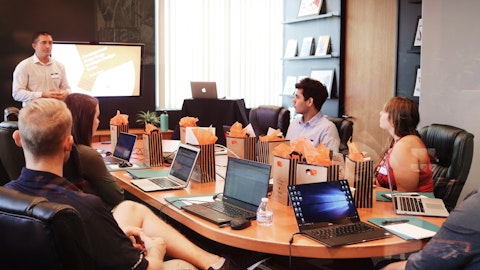Chris Lapointe : Yes. So thanks, Dan, for the question. So we aren’t providing specific views on how things are trending right now. But what I would say is, on the student loan front, through January, as mentioned in our guide, we expect it to be at the existing run rate levels that we saw in Q3 and Q4. In personal loans, things are progressing. As one would expect, there’s a lot of headroom in that business, but we’re being mindful with respect to credit. And then on the home loan side, we have made some really good progress over the course of the last two to three months in terms of some of those fulfillment issues that we’ve talked about previously and things are trending in the right direction. Anthony, I don’t know if it’s anything you’d add there?
Anthony Noto : Yes. The only other thing I’d add, Dan, as I did say in my prepared remarks that we’re seeing the strong trend in member and product growth continue to Q1. We’ve, throughout the year, constantly iterating on marketing channels, on marketing messages, on life cycle marketing and leveraging the most efficient channels. And I feel like, in the fourth quarter, we — it was a culmination of a lot of work over the last two years, and we saw the benefit of that. And as we started the new year, we continue to see that. So we feel really great about not just the growth rate in members as well as products, but the quality of those members and product adoption in addition to the cost of acquisition.
Operator: Our next question comes from the line of Ashwin Shirvaikar of Citigroup. Your line is now open, please go ahead.
Ashwin Shirvaikar : Thank you. Congratulations on the results. Questions on the process of transfer to new fulfillment partners. And you just mentioned the last two, three months have been good, Chris. But what should investors expect in terms of time line, financial impact? It’s been a few quarters this has come up, and what’s the main factors that seem to be, I guess, affecting a more timely transition?
Anthony Noto : Yes. And just to give you a little bit of history here, we had a partner that was helping us drive great success on the back-end fulfillment side of the equation. We do the — we do the marketing to drive the demand at the top of the funnel. We do the underwriting for the loans. And after that, loan is locked. We partner with a film partner to get through all the all the steps after that. That partner unfortunately got acquired. We were then required to make a technology platform switch with the new acquired company, which was costly and time-consuming. And ultimately, the economics that entity was seeing became quite onerous as rates increased, and we realized that the economic relationship that we had was changing, and we needed another partner.
We started pursuing other partners, quite frankly, well before that acquisition happened just needing diversification. And so we fast-tracked the second partner that we needed to transition to. That transition didn’t happen as quickly as we would hope. I will tell you, in the last two months, we’ve seen more progress there than we have in the last 18 months, and I’m encouraged by the progress the team has made, both in terms of the technology integration, the process flow, the ability to hit time-to-funding metrics and serve our members better. We’re nowhere near perfect, but we’re starting to move in the right direction for the first time in a while. In terms of the economic impact on the overall business, Chris was pretty clear in saying that it will ramp throughout the year.
I would think about it as more second half of the year than the first half of the year. But the team is executing in a way that I think positions us really strongly to start stepping on the gas a little bit more as it relates to demand. We’ve had our foot off the gas, quite frankly, because we don’t want to generate demand that we can’t fulfill in a high-quality way. And we’re starting to get to the point, I think, we’ll be there by the second half of the year where we can step on the gas and start to see a much bigger market share gain there. We have such a small market share. Even with higher interest rates, I think there’s a huge opportunity for us to drive revenue there as well as that revenue being profitable. In addition to that, we do, at some point, similar to the rest of our businesses, want to own end-to-end.
We own lending from metal to glass, so to speak, and it gives us such advantages on iterating, on testing, on pricing, on credit, on user flow, on fraud, on risk. And we see the same thing now in SoFi Money, owning Galileo and having the benefit of Technisys as well. And so at some point, in home volumes, we’ll own the back end also. We’ll always partner. It’s great to have two sources of capacity, especially given our aspirations and how big we think this could be. It is a huge financial transaction for our members. It is emotional transaction, and we need to be able to scale it and meet the needs of all of our members, and that’s where we’re focused on long term.
Operator: Our next question comes from the line of John Hecht of Jefferies. Your line is now open, please go ahead.
John Hecht : Thanks for taking my question. Again also you talked about B2B estimates starting up. And you guys have on live in the uses and members and change in terms of marketing and customers and members. And how do you think about any opportunities in 2023?
Anthony Noto : John, it was really hard to hear your question. I don’t want to guess what your question was. Maybe you could just dial back in with a better connection. I heard something about B2B and that it was pretty muted after that.
John Hecht : Is this better? Sorry, guys, is this better?
Anthony Noto : Yes. Perfect. Thank you.
John Hecht : I’m sorry, can you hear me now?
Anthony Noto : Yes, we can hear you.
John Hecht : Okay. I apologize as my headphones are bad. The question was just, Anthony, you mentioned B2B activity. You guys clearly still have very positive momentum with new members and new customers. I’m wondering, given your channels of customer acquisition, the cost of customer acquisition, has there anything changed from a characteristic perspective? And how do you look at opportunities from that regard in 2023?




